
AI is everywhere these days, and ChatGPT is one of its main ambassadors. Is it an industry killer and job-taker or a savior in digital flesh? These questions have bothered everybody since GPT was introduced to the public. As time went on, the technology adapted, yet the controversies raged on. However, the savviest specialists out there were fast to add this huge database of responsive knowledge to their toolset.
Namely, website and app developers have found a rich and handy source of inspiration, templated takeaways, and actionable tips in using ChatGPT for user interface design. How can it make a designer's job more time-efficient and easier on the nerves? Let's find out.
Understanding ChatGPT opportunities in UI/UX design
Despite common beliefs and misconceptions, there is much more to ChatGPT than a chatbot-esque functionality tuned for responding to queries and contemplating various topics in real-time. Just below the surface, it is a potent tool that can take on roles, analyze niche concepts, and deliver required information in just the right format.
In savvy hands that know how to leverage ChatGPT for UI design, this smart assistant becomes a powerful workflow automation solution for UI/UX designers of any level. That is if you manage to come up with efficient wordings to leverage the Chat's vast digital intelligence.
We'll show you how exactly you can handle that and more, all for the sake of an AI-boosted design workflow (and an easier life for you as a busy specialist).
7 benefits of using ChatGPT for UI design
There are certainly a lot of professional routines when it comes to UI/UX design, from regular ideation and targeted research to listing, structuring, summarizing, referencing, etc. Many of these can be delegated to a machine if you know how to use ChatGPT for UI/UX design. Here is what you can do:
Get feedback on a design concept or prototype
The foremost thing that makes ChatGPT stand out as a relevant smart tool is the extent of topics it can cover. From global scientific and tech themes to niche business areas, it is an endless well of data and the first AI model ever to be trained using such a massive scope of input knowledge.
Naturally, ChatGPT always has something to say about this or that topic. In terms of UI/UX design, it holds tons of insights and know-how that could help you conceptualize and guide, say, an interface prototype completion.
For instance, you can feed ChatGPT a design brief or a list of features/UI elements and ask it to finalize it by suggesting what elements might be missing from the design.
Input example:
Here's a list of UX elements for a food delivery mobile app's design concept:
Main screen
Food categories
Checkout
Support button
ChatGPT output:

Create user stories
A user story, user persona, or user journey roadmap are irreplaceable elements of target audience research. You simply can't do without one, whether you need to promote and sell or personalize a design in line with particular demands and expectations.
The user story must certainly be unique to a specific persona or demographic and tuned for your segment (e.g., formal or artsy project, wide or niche audience). But, it is mostly a template for a slightly differing user experience, where all essential and decisive factors (user portraits, pains, likes, habits, etc.) can be shuffled and switched at will.
You can get the basic user story descriptions through ChatGPT prompts for UI design, adapting them however needed and adding sufficient elements to achieve more authentic outlines.
For instance, ChatGPT went into some insane detail generating a user story for a manager-tailored UI when prompted with this input:
Input example:
Generate a user story for an IT manager seeking an all-in-one interface to handle tasking and workflow management with the goal of boosting productivity.
ChatGPT output:
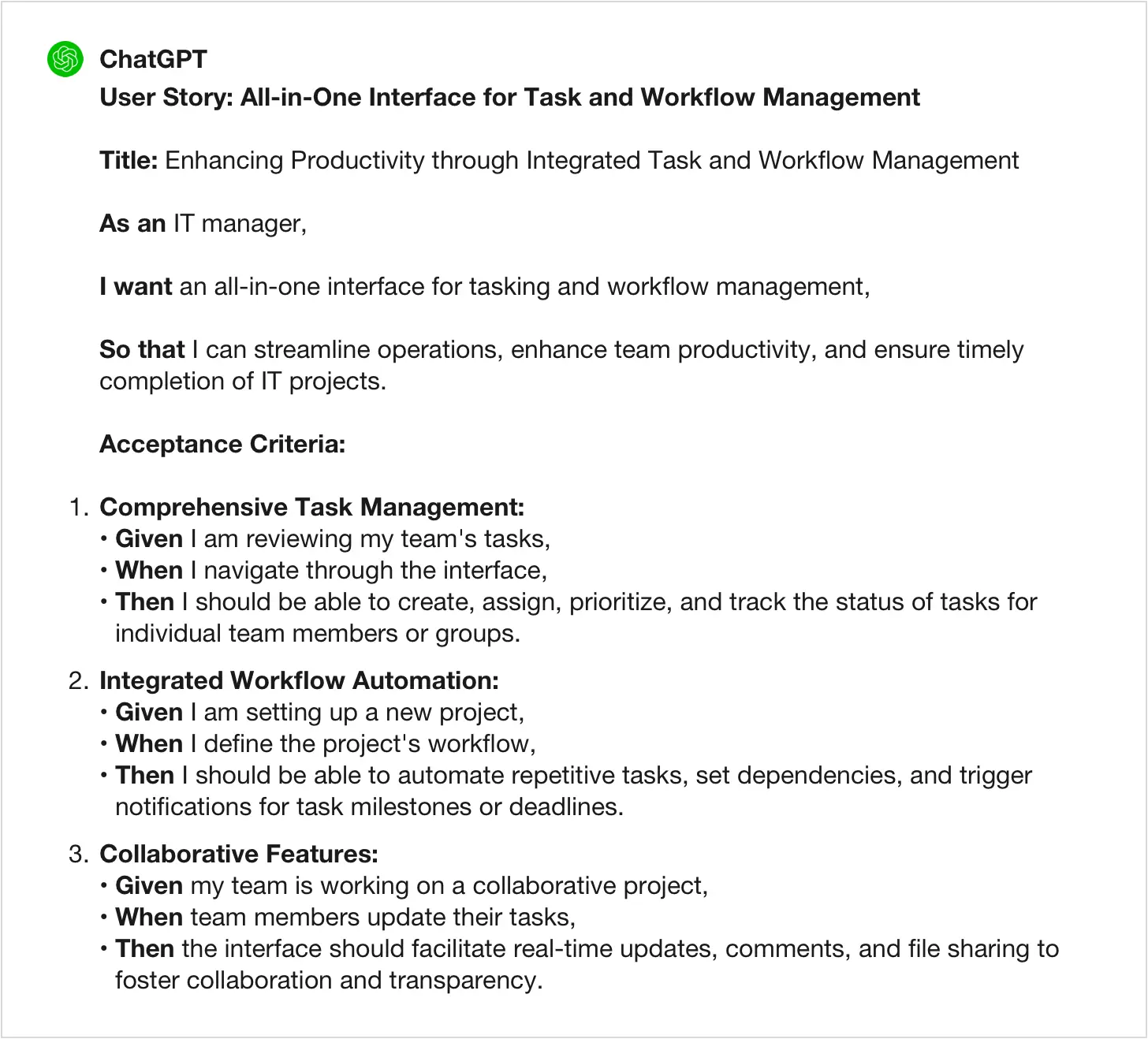
Brainstorm user flows and interactions
If you are doubting UX ideation and conceptualizing, you can use ChatGPT for UI design more directly by asking specific questions. A user flow brainstorming session is usually a scrupulous, stage-by-stage process where no stone must be left unturned, making it a perfect process to utilize some automation.
How can UI navigation be made more concise and intuitive? What elements can I leave out, and which are must-haves for a user-friendly UX? Narrowing down such questions into specific ChatGPT prompts can help you efficiently fill the gaps.
Here's how ChatGPT handles the task of coming up with competitive UI/UX elements for a "like an X" type of product.
Input example:
I am working on an independent FinTech app like Cash App. What UI/UX elements can help me optimize it for a B2B IT business audience?
ChatGPT output:
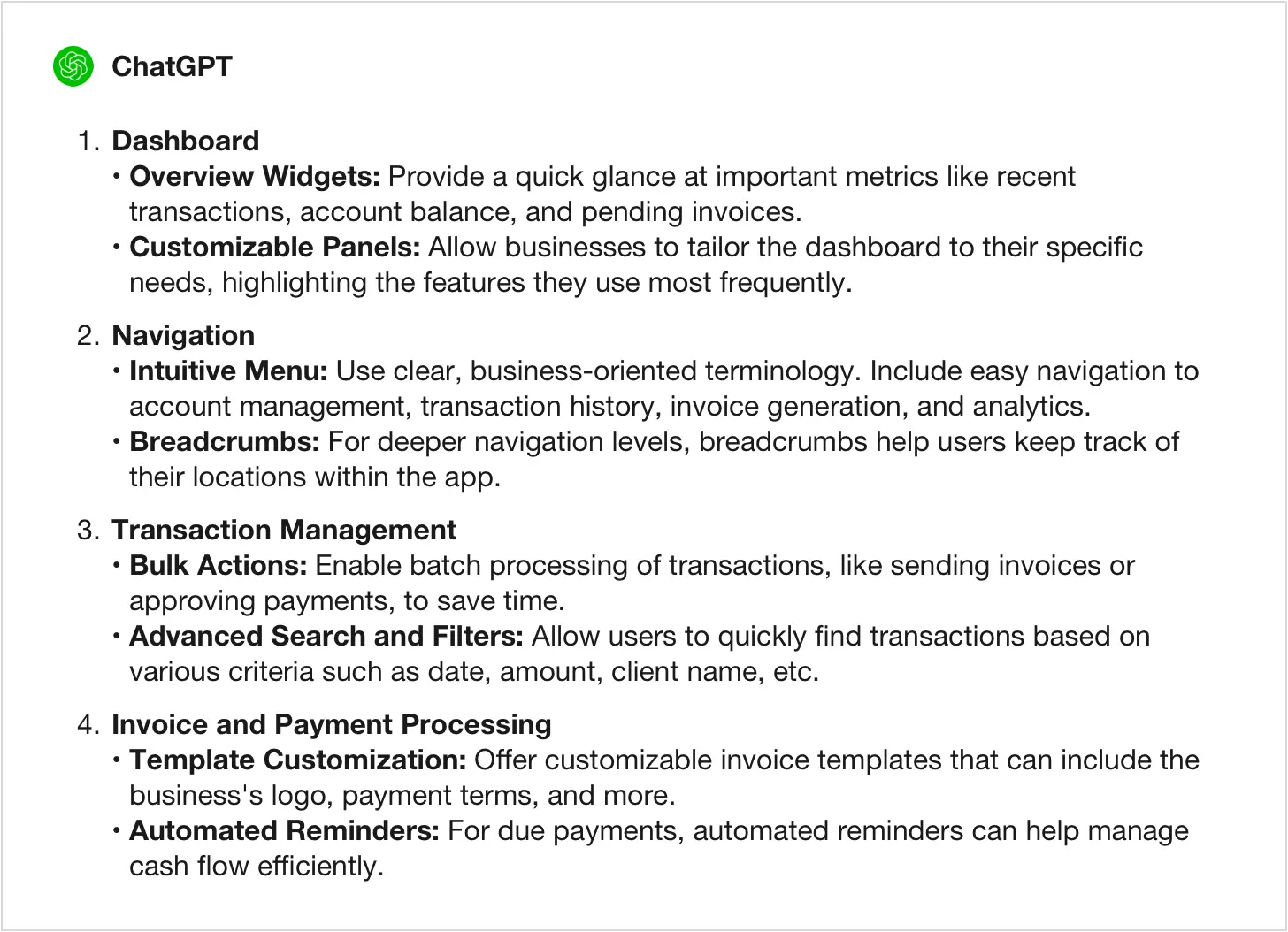
Get accessibility recommendations
ChatGPT can quickly provide information on the latest accessibility standards (such as WCAG guidelines) and help product designers understand what these norms look like in practice.
Furthermore, by analyzing vast amounts of data on user needs, AI can suggest inclusive design elements, like color schemes for the color-blind, better readable text sizes, and interactive elements for people with motor difficulties.
You can seek advice based on unique scenarios, like designing an app for geographically remote users who might have poor Internet access.
Input example:
What features do I need to make my messenger app accessible in regions with problematic Internet connections?
ChatGPT output:
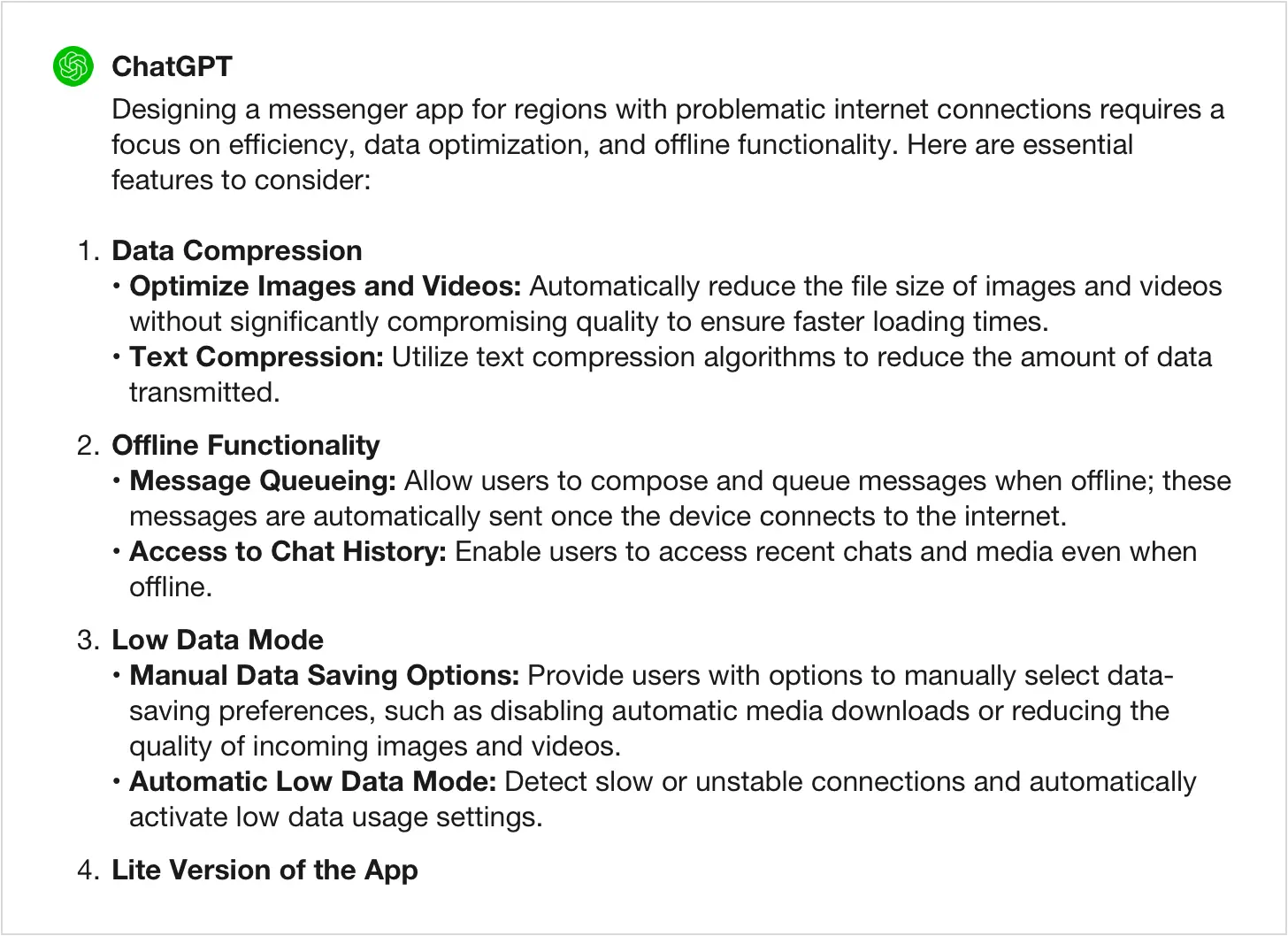
Prepare meaningful checklists
ChatGPT's ability to template, sort, and structure things is simply unparalleled. Custom-generated checklists can cover every stage of the design and further interface development workflow, helping you keep everything in check.
As such, themed checklists may even serve as quality assurance tools, providing convenient "cheat sheets" for reference to see whether the final product meets all technical, design, and UX requirements before launch.
Custom checklists can be built on the pre-generated user personas or project requirements and research input data. As you can see in the example below, the Chat took all the previous inputs detailing my FinTech/messenger app plans and built upon them in the new checklist.
Input example:
Generate a UX criteria checklist for the B2B-oriented FinTech app I mentioned.
ChatGPT output:
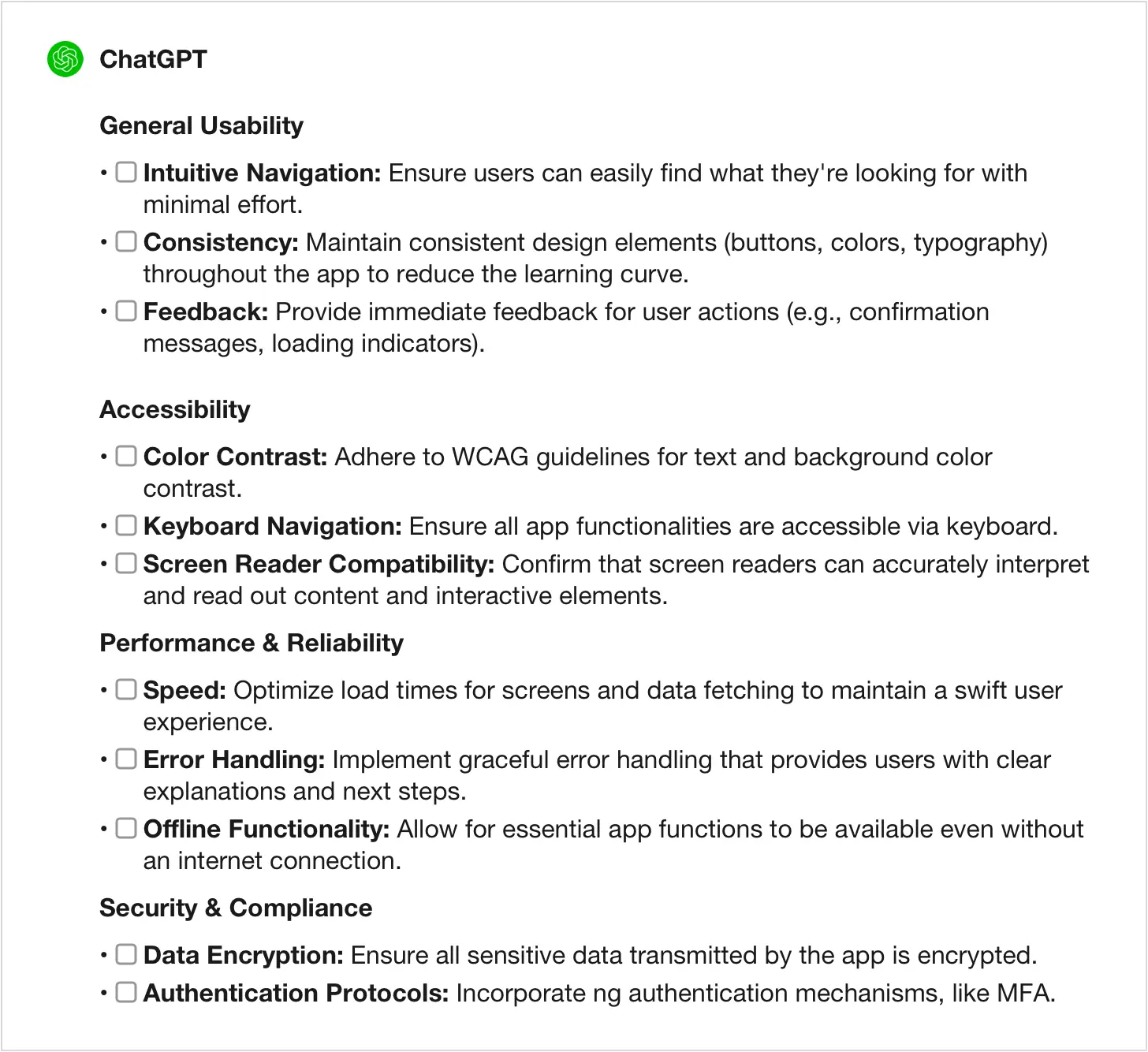
Generate wireframe layouts
ChatGPT can suggest layout ideas and software structures based on the intended product functionality, which can speed up the wireframing process.
Designers and developers can analyze the custom user flow and functionality in the Chat and refine the logic behind their wireframes, e.g., with call-to-action elements, content prioritizing advice, and critical elements for different scenarios. Here's an example of how to use ChatGPT for UI summaries.
Input example:
Which basic features will my app require for the MVP phase?
ChatGPT output:
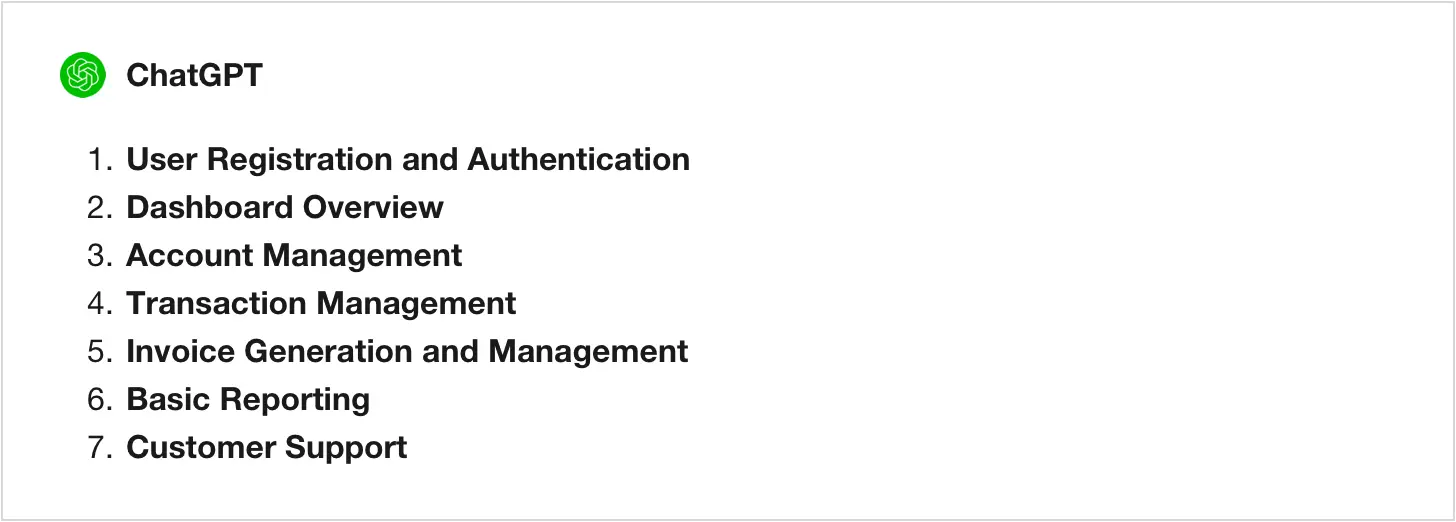
Get ideas for UX testing tasks
Last but not least, you can get even more design research and evaluation data by generating targeted UX testing cases. Again, the Chat can summarize all the previous project-related inputs very well — just make sure you stay in the same chat tab.
When asked to create an outline for a specific UX test, ChatGPT demonstrated some well-detailed, scrupulous results.
Input example:
Compose a conceptual UX test intended to gather MVP-phase feedback on the design of a new offline-equipped payment app for remote regions.
ChatGPT output:

Drawbacks in UI design creation with ChatGPT
By now, you should have gained a pretty good idea about utilizing ChatGPT for user interface design, but it's no less crucial to know what NOT to do with it. Remember, ChatGPT:
Doesn't have the same level of human experience and empathy
The digital algorithm in place of the brain, heart, and soul is the most visible drawback of the Chat by far. In more practical terms, you should always keep in mind the "auxiliary tool" nature of AI. It doesn't mind repetitive and routine tasks, which is exactly what you should leverage it for the most (formal tasks, lists, summaries, consulting advice, etc.), but might struggle with more involved parts of the development process.
Needs double-checking for all conclusions and recommendations
"ChatGPT can make mistakes. Consider checking important information." While using ChatGPT AI for UI design is unlikely to result in spreading misinformation, you should always double-check how accurate and relevant its data is (some people fail to understand that it isn't really a "push-to-win" solution, and that can lead to pretty dire consequences).
Lacks originality and uniqueness
Can a robot draw an art piece or write a poem? Surely, it can, albeit one summarizing the references it was fed beforehand and the expectations of what you wish to see. Such creations are inherently non-original and imitative.
Consider Dworkz, your trusted partner for creating a definitive user interface
Dworkz is a one-stop UI/UX design and development company. We combine years of live market experience with the expertise of seasoned specialists ready to jump into a project of any scope.
We've been leveraging in-depth skills and the market's best practices to drive the top-of-the-line, pitfall-free implementation of desktop, mobile, and web UIs of all purposes and complexities. The list of achievements we're proud of include:
400% conversion rate boost for SuperGIF, a content marketing platform for specialists.
Upping user satisfaction rates up to 99% for Kantola, an online professional training platform.
A website built from scratch for Bullet Point Network, a smart investment platform.
So, what are you waiting for? Let's discuss, plan out, and build a tailored UI/UX solution that can engage, motivate, and convert with equal ease.
Final Thoughts
The examples above demonstrate in action the way you can streamline and automate UX/UI design with ChatGPT. It certainly proves to be a worthy tool in savvy hands. Try it out and see where it takes you. However, make sure not to demand too much of the AI, as it simply can't provide the same level of authenticity as you. We can and should delegate senseless routines to it, but there are still a lot of tasks that demand a human touch.
FAQ
Can ChatGPT 4 generate UI design?
Yes, theoretically, it can. However, you must first figure out how to make it do so, as a simple request won't suffice. In particular, to get a suggestion or UI outline description, you need to carefully formulate a clear, detailed prompt. This means you must know exactly what you are looking for.
How can UI design be improved by using ChatGPT?
You can use ChatGPT for UI design in many ways, most of which are discussed in the article, but in short, it helps with routine and ideation. Suppose you already have an existing app design. Chat can offer more industry-specific features, e.g., financial elements for e-commerce solutions, if it's a basic touchscreen user interface design.
Can ChatGPT generate UI mockups?
ChatGPT's UI design outlines can only be rough and basic, listing elements and features, structuring them into categories, and providing advice here and there. However, you can achieve better results if you provide enough info and ask the Chat to analyze and structure it from different angles. Note that the more sophisticated UI design techniques remain beyond the AI's reach at the moment.


